Ladybug Life Cycle: Eggs, Larvae, Pupae, Adult (With Pictures) – Identification Guide
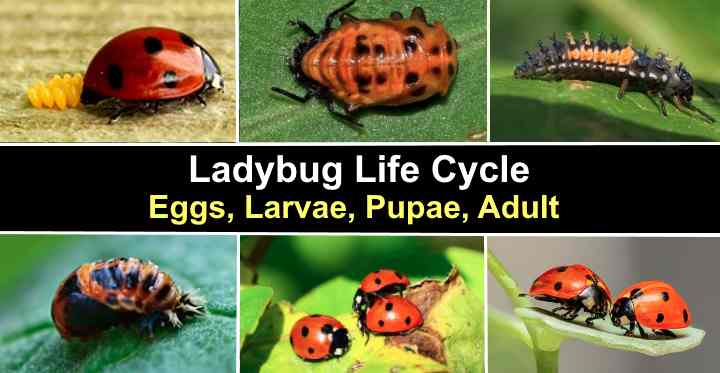
A ladybug has four stages of its life cycle—the egg stage, larval stage, pupal stage, and adult stage. Like the life cycle of most insects, ladybugs look entirely different in each cycle. From a tiny egg less than 0.04” (1 mm) in size to a small flying beetle with spotted wing covers, an adult ladybug can live for up to 12 months.
Knowing about the ladybug life cycle is helpful if you want to increase their numbers in your garden, as adult lady beetles feed on soft-bodied insects. This fact makes ladybug species beneficial insects that feed on aphids and other plant-infesting bugs.
This article will discuss the different stages of the ladybug life cycle and what happens during each phase. Pictures and descriptions of ladybugs will show what the eggs, larvae, pupae, and flying adult insects look like.
What is a Ladybug?
Ladybugs are a type of beetle belonging to the family Coccinellidae. Most ladybug species are red and black insects with domed wing covers. After emerging from the pupa, a ladybird has six legs, a pair of antennae, and two pairs of wings covered by spotted elytra (wing covers).
Ladybugs are typically black with red spots. However, the flying, winged insects can be brown, yellow, or black. Also, depending on the species, they may have striped wing covers or no specific markings.
Ladybugs also go by the names lady beetles or ladybirds.
Four Stages of the Ladybug Life Cycle
A ladybug’s life cycle has four stages. First, the female ladybug lays clusters of five to 30 yellow, white, or grayish eggs. Then, after two to ten days, larvae emerge from the eggs and live for 12 to 20 days before they enter the pupal stage. Finally, after 15 days, adult ladybugs emerge.
Ladybug Eggs

A close up picture of ladybug eggs (left), and ladybug eggs on a leaf underside
Ladybug eggs look like tiny shiny jellybeans and are either oval or spherical. The eggs are in clusters under leaves. Depending on the ladybug species, the eggs measure 0.001” to 0.01” (0.25 – 2.5 mm) in size. Ladybug eggs can be yellow, green, orange, or grayish.
Depending on climatic conditions, the ladybug egg stage can last from a couple of days to ten.
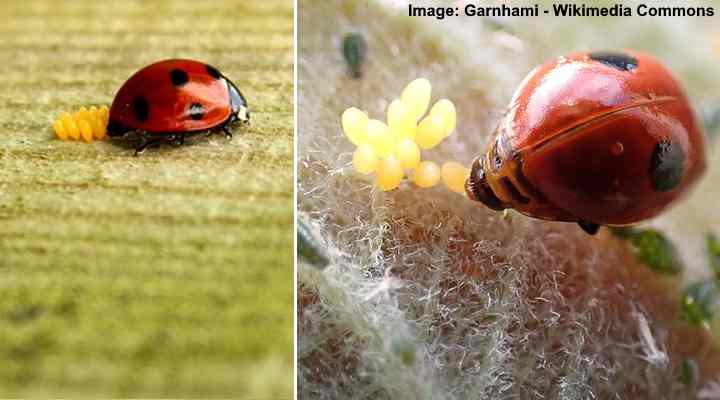
Ladybugs laying eggs
Ladybug Larvae
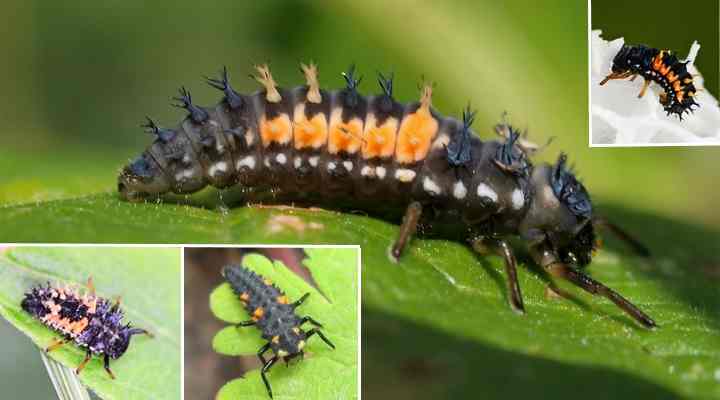
Ladybug larvae are typically black with orange markings
Ladybug larvae are typically black with a spiny body in a carrot shape. The slender, bumpy insects can have orange or yellow bands or spots depending on the insect species. Ladybug larvae feed on aphids and live for up to three weeks. Ladybugs molt several times during the larval stage.
Ladybug Pupa
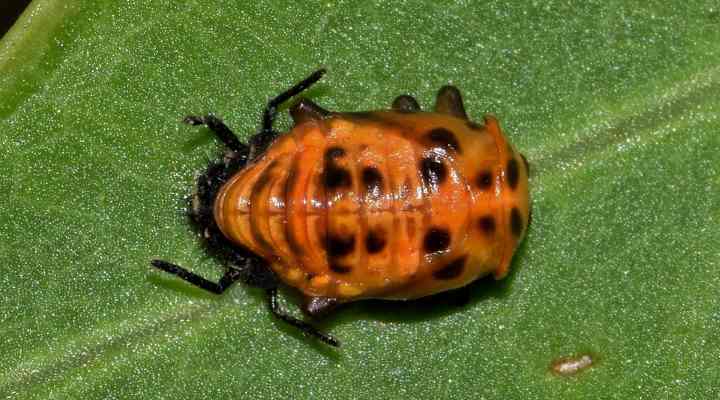
A close up image of ladybug pupa
Ladybug pupae look like squashed or wrinkled larvae that are bright orange or yellow with black markings. Ladybugs pupate for between one to two weeks. During this time, they completely transform from spiky-looking, slender, soft-bodied insects into vibrantly colored adult flying beetles.
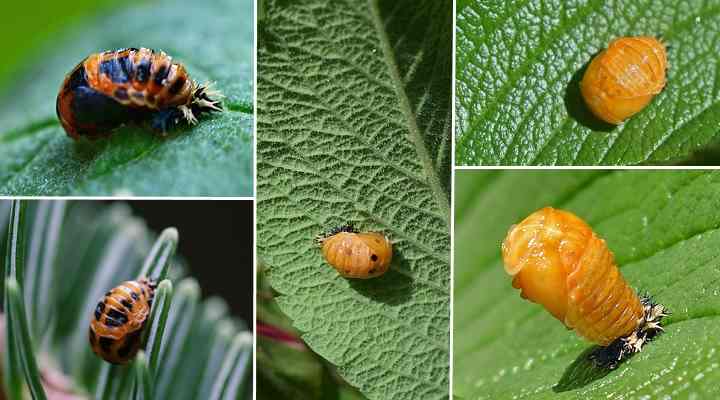
Pictures of ladybugs pupa
Adult Ladybug
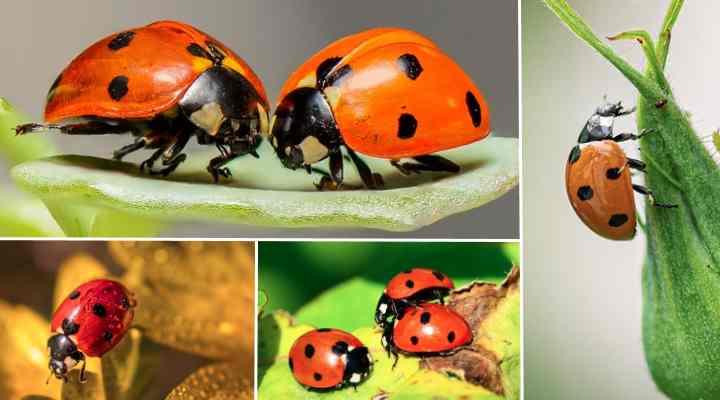
Adult ladybugs are typically red with black dots but can have other colors
The final stage of a ladybug’s life cycle is when it emerges from the pupa as an adult. Ladybugs have easily recognizable rounded or domed shapes, shiny elytra, and a flattened underside. Unlike many other insects, the adult stage of a ladybug is relatively long because they live for up to one year.
Ladybug Eggs — Identification Guide
The ladybug’s life cycle starts as an egg. The eggs are so tiny they look like colorful specks in small clusters on plant stems and on the underside of leaves. With some species of ladybugs, females can lay over 1,000 eggs in a three-month period during spring and early summer.
After laying the eggs, the larvae take approximately two to ten days to hatch. The females lay eggs near colonies of aphids, mites, and other small insects. This provides a food source when the larvae hatch.
An interesting fact about ladybug eggs is that the female insect lays infertile and fertile eggs. It is thought that this habit is so larvae have a nutritious source (the infertile) eggs when they hatch and if there are insufficient aphids.
What Do Ladybug Eggs Look Like?
Ladybug eggs resemble tiny jelly beans or pearls, measuring between 0.001” to 0.01” (0.25 – 2.5 mm). The eggs are either yellow, orange, greenish-gray, or white and are typically found in clusters on the underside of leaves or on stems. The eggs are typically too small to notice on their own.
Ladybug eggs on the underside of leaves are more noticeable because the female lays them in clusters. The eggs may look like small patches of yellow, orange, or grayish dots
Ladybug Larval Stage
The growing and changing stage is the second stage of the ladybug life cycle. The small spiny black larvae emerge from eggs during this second stage of their life cycle. The bug larvae are covered in tiny bristles, giving them a menacing appearance. The larvae grow from 0.05” (1 mm) after hatching to 0.40” (10 mm) before pupation.
Ladybug larvae are generally dark blue to black with some brightly colored yellow or orange marking. You can identify the larvae because they have six legs attached to the thorax. They also have stumpy fleshy spikes covering their segmented bodies.
Ladybug larvae usually have four instars or molt stages. After each molt, the creepy crawlies shed their exoskeleton as they grow in size to around 0.40” (10 mm) before pupation. The alligator-like bugs gorge on aphids and other soft-bodied insects during this time.
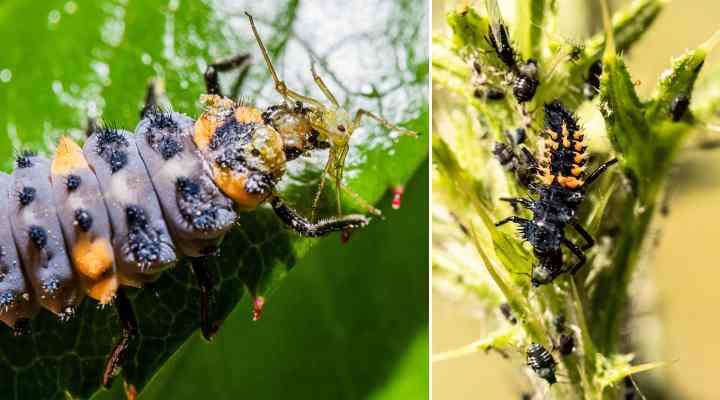
Ladybug larvae eat aphids
Typical ladybug larvae are in their larval stage for two to four weeks, depending on the species and climatic conditions.
Ladybug larvae have a voracious appetite and can consume up to 400 aphids a month. That means a small cluster of hatched ladybug eggs can eat more than 6,000 aphids or other pests in your garden in four weeks. However, the larvae become cannibalistic if there is a shortage of aphids.
What Do Ladybug Larvae Look Like?
The larvae of ladybugs look like tiny alligators with fleshy spines covering their bodies. The color of the larvae is typically black with orange or yellow markings on their backs. Like most insects, they have two antennae.
Ladybug Pupal Stage
The ladybug pupal stage is when metamorphosis occurs. During this stage, the larvae form a protective shell around themselves and undergo a transformation that will eventually turn them into adult ladybugs. The small colorful pupae measure between 0.19” to 0.31” (5 – 8 mm) long.
Unlike caterpillars, ladybug larvae don’t form a cocoon. Instead, they develop protective tissue around themselves when the larval skin hardens. Typically, the ladybug pupae look like small orange, brown, or yellow bumps stuck to plant leaves.
During pupation, ladybug larvae go through a metamorphosis. Then, the larvae break down and reform into winged insects with six legs, two antennae, and colorful wing covers. This process of pupation takes from five to 14 days.
After the pupation stage is complete, the ladybug hatches, leaving behind an empty pupal case called a puparium.
What does a ladybug pupa look like?
The pupa of a ladybug’s metamorphosis stage looks like a tiny orange or yellow shrimp stuck to plant foliage.
Adult Ladybug Stage
The final stage of a ladybug’s life cycle is when the adult insect emerges from the pupa. Most ladybug adults are red insects with black spots. However, there is tremendous variation in the appearance of ladybugs, even from the same species. Adult ladybugs measure between 0.03” and 0.70” (0.8 – 18 mm).
Adult ladybugs emerge from the puparium with relatively soft bodies and soft elytra. However, within a few hours, the wing covers harden, making the flying insects difficult for predators to consume. As the shell hardens, the elytra develops vibrant colors and distinctive markings.
A distinctive feature of the ladybug life cycle is that they typically live longer than most insects. Most ladybug species live for around 12 months. During winter, adults congregate in clumps and live under dead vegetation, rocks, or in grass tussocks.
After the dormancy period, ladybugs become active again in spring, when the females mate with a male, lay eggs, and continue the ladybug life cycle. In tropical climates, ladybugs become dormant in the dry season. In temperate climates, they are dormant in winter.
What Do Adult Ladybugs Eat?
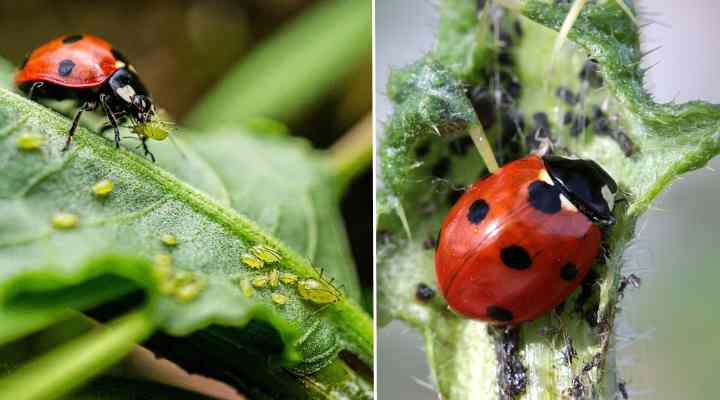
Ladybugs eating aphids
Adult ladybugs are beneficial insects that feed on aphids, scale insects, mealybugs, and other soft-bodied pests. They also consume pollen and nectar from flowers, especially coriander, alyssum, and dill. These ladybug facts make them highly beneficial insects in a greenhouse or garden. Not only do they prey on pests, but they assist in pollination.
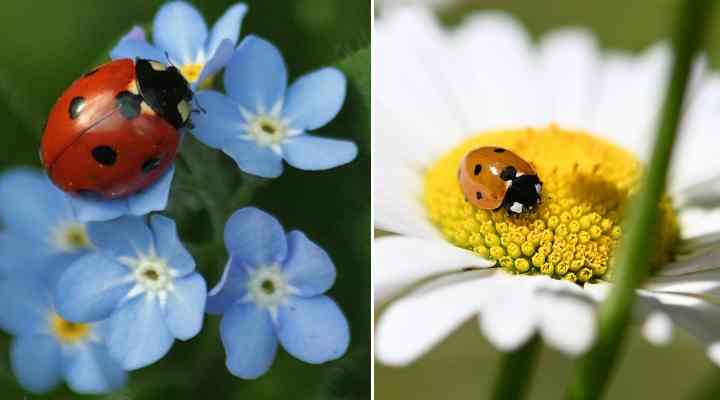
Ladybugs consume pollen and nectar from flowers
Common Types of Ladybugs
Ladybugs are an incredibly diverse species of insects. These colorful flying “bugs” come in various shapes, sizes, and colors, making them one of the most recognizable insects. There are over 5,000 species of ladybugs worldwide. The most common North American species is the seven-spotted ladybug.
Here are features of some common ladybugs you will likely find in garden landscapes:
Seven-spotted ladybug (Coccinella septempunctata): This red ladybug is identified by its seven black spots on its elytra. Also called the C-7 ladybug, it has three pairs of black spots on each red elytra and a single central spot behind the thorax. The large ladybug measures 0.39” (10 mm) long.
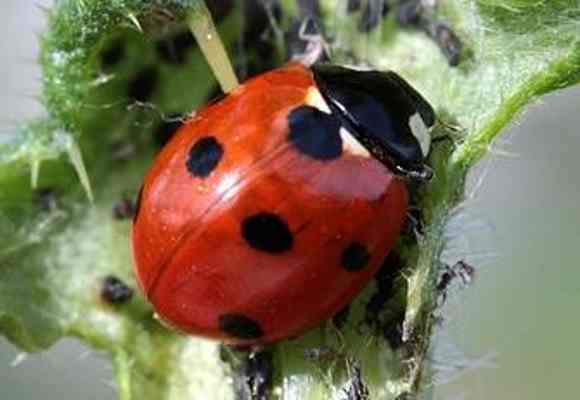
Seven-spotted ladybug (Coccinella septempunctata)
Two-spotted ladybug (Adalia bipunctata): This common ladybug species has two black spots on the red wing covers. These beautiful bugs come in shades of red, yellow, or orange and can be found across North America.
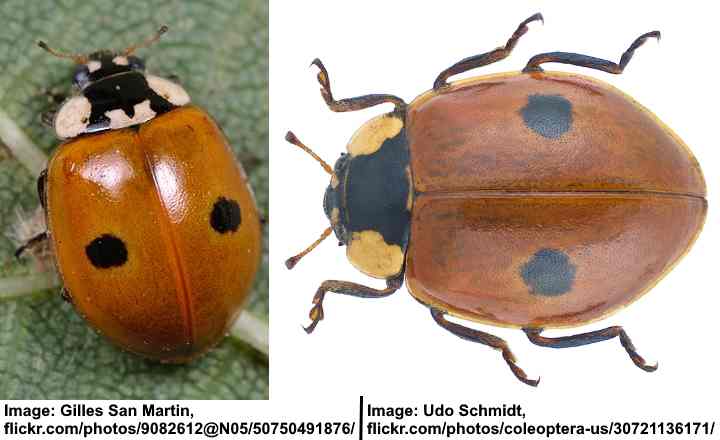
Two-spotted ladybug (Adalia bipunctata)
Asian lady beetle (Harmonia axyridis): This non-native ladybug is a red beetle with black spots in the family Coccinellidae. The invasive pest is identified by its many black spots on its back, voracious appetite, and small size. Unfortunately, these pesky bugs are among the few ladybugs that bite and cause allergic skin reactions.
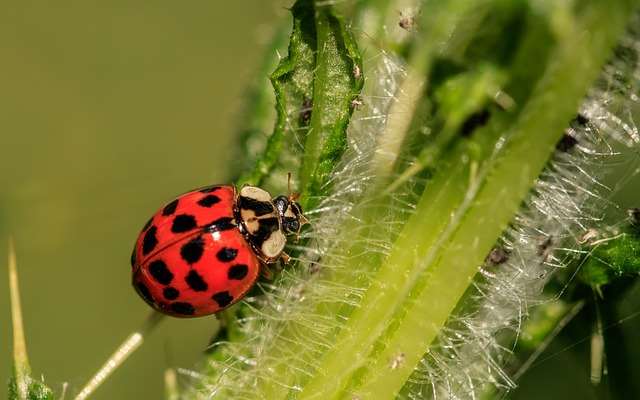
Asian lady beetle (Harmonia axyridis)
Convergent ladybug (Hippodamia convergens): One of the most common lady beetles in North America is the convergent ladybug. These orange-reddish, flying beetles are identified by the 12 black dots on their wing covers and white markings on their thoraxes. The larva of the convergent ladybug is a dark blackish charcoal color with colorful yellowish markings.
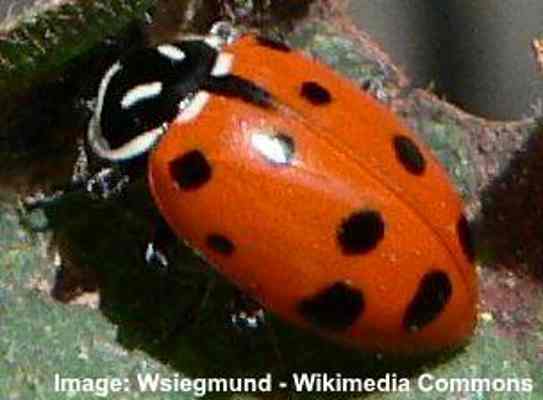
Convergent ladybug (Hippodamia convergens)
California ladybug (Coccinella californica): The identifying feature of this native ladybug is its orange-red elytra without any recognizable black spots. However, the orange beetle has white markings on its head and thorax. It measures 0.20” (5 mm) long.
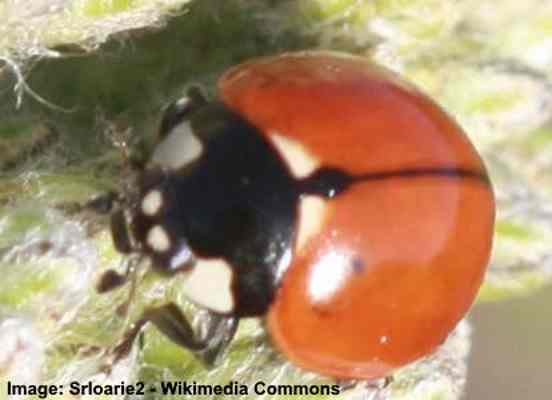
California ladybug (Coccinella californica)
Discover many other types of ladybugs and learn how to identify them.
Ladybug Habitat
Ladybugs are found in various habitats, including woodlands, grasslands, and meadows. However, they prefer to live in areas with abundant vegetation, such as gardens, parks, and agricultural fields. Ladybugs also thrive near lakes, ponds, rivers, and streams. The main food source of ladybugs is aphids.
Habitats where ladybugs are common include orchard crops, various vegetables, wheat, and sorghum. The flying bugs are also common where crops that aphids prey on are also popular. Interestingly, ladybugs can adjust their life cycle according to aphid availability.
How Long Do Ladybugs Live?
Adult ladybugs generally live for up to a year in ideal conditions. Their success depends on access to plenty of food, such as aphids and other small insects, and a warm climate with open habitats like grasslands, meadows, and forests. However, their lifespans may be shorter in colder climates due to harsh weather conditions.
No matter how long they live, it’s important to remember that ladybugs play an important role in controlling pest populations in gardens. So if you want to attract more of these friendly bugs into your garden or area, consider providing them with a pleasant habitat with plenty of beneficial vegetation.
Insects that Look Like Ladybugs
Asian lady beetles are the most common bug that resembles ladybugs. Although the beetles are in the same family, Coccinellidae, they act differently. Asian ladybugs look identical to native ladybugs, but they can become invasive and bite humans. They also leave a foul-smelling substance on surfaces.
To tell the difference between native ladybugs and Asian lady beetles, here are a few tell-tale differences:
- Asian lady beetles are longer and slightly larger than native ladybugs.
- Lookalike ladybugs have a distinctive black “M” marking on their white heads.
- Asian ladybugs have a tendency to enter homes to overwinter, whereas native ladybugs spend their winters outdoors.
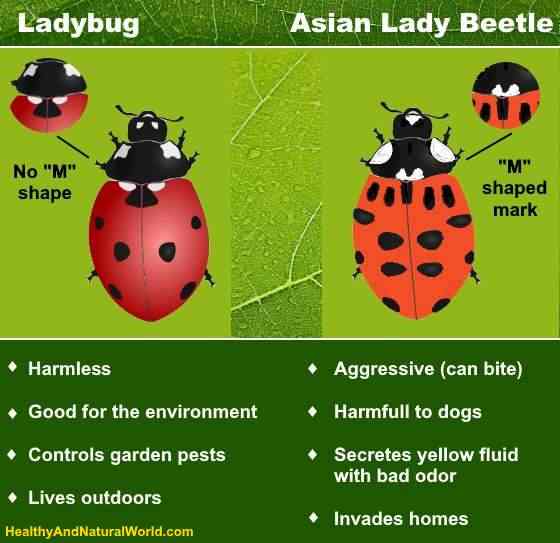
Ladybug vs. Asian beetle
Here are some identifying features of other bugs that resemble native ladybugs:
Mexican bean beetle (Epilachna varivestis): Mexican bean beetles are yellowish-orange with black spots. They are typically found in fields or gardens that grow beans, peas, or other legumes. To identify them, look for tiny round holes in the leaves of the plants they feed on. These ladybug lookalikes only feed on plant matter, not other insects.
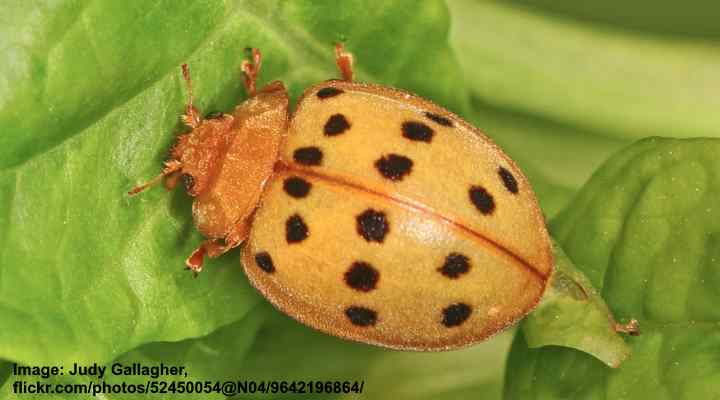
Mexican bean beetle (Epilachna varivestis)
Colorado potato beetle (Leptinotarsa decemlineata): These large pale orange-yellowish and black striped beetles are easily differentiated from native ladybugs. The orange beetles have ten black stripes, measure up to 0.43” (11 mm) long, and prey on plants in the family Solanaceae.
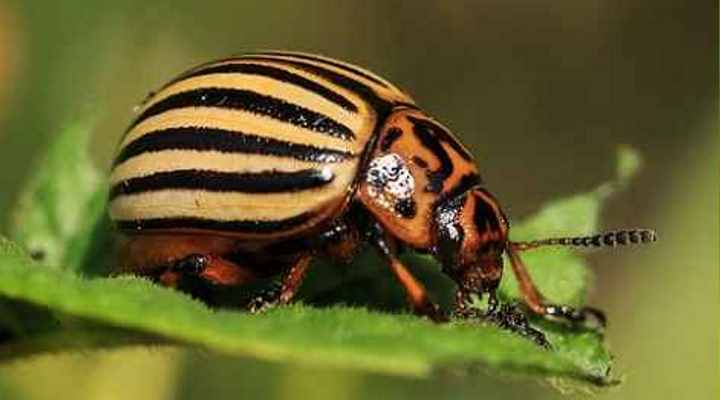
colorado potato beetle (Leptinotarsa decemlineata)
Scarlet lily beetle (Lilioceris lilii): Scarlet lily beetles are a bright red color and measure 0.23” to 0.35” (6 – 9 mm) long. The ladybug-like beetles have vibrantly colored bodies but are more elongated than typical ladybugs. The red beetles are more similar to cardinal beetles than true ladybugs.
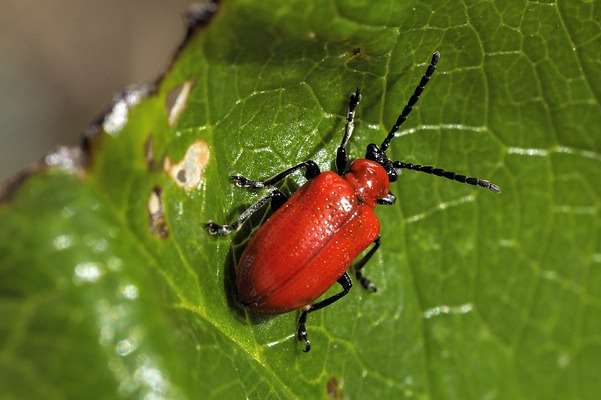
Scarlet lily beetle (Lilioceris lilii)
Related articles:
